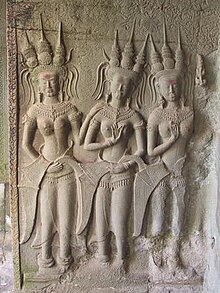| Revision as of 13:48, 14 May 2004 editPratyeka (talk | contribs)Extended confirmed users8,789 edits move & resize image← Previous edit | Revision as of 14:04, 14 May 2004 edit undoPratyeka (talk | contribs)Extended confirmed users8,789 edits added longmen apsaraNext edit → | ||
| Line 3: | Line 3: | ||
| Apsaras are often depicted in ] art as far afield as ] and ], however. | Apsaras are often depicted in ] art as far afield as ] and ], however. | ||
| ] | |||
| {{msg:stub}} | {{msg:stub}} | ||
Revision as of 14:04, 14 May 2004

In Hinduism, the Apsaras (also Vrikshakas) are nature spirits, all the female wives of the Gandharvas. They danced to the music made by their husbands, usually in the various gods' palaces.
Apsaras are often depicted in Buddhist art as far afield as Cambodia and China, however.

This article is a stub. You can help Misplaced Pages by expanding it. |